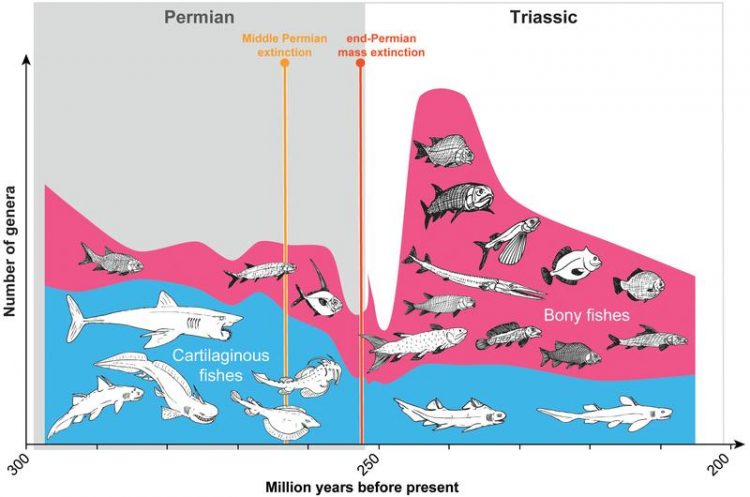Mass extinction led to many new species of bony fish

after severe losses among cartilaginous fishes during the Middle Permian extinction, bony fishes experienced a massive diversification in the subsequent Trias period. Picture: University of Zurich
Today, ray-finned fish, which belong to the bony fish, are by far the most biodiverse fish group in both salt- and freshwater. Their spectacular variety of forms ranges from eels, tuna, flounders and angler fish all the way to seahorses.
With around 1,100 species, the second most biodiverse group is the cartilaginous fish, which are almost exclusively marine and include sharks, rays and chimaeras. Exactly why bony fish managed to prevail in different habitats is the subject of debate: Do they have a better body plan, which is suited to more ecological niches than that of the cartilaginous fish? Or are other factors involved in their successful distribution? Paleontologists from the University of Zurich now reveal that climate catastrophes in the past played a crucial role in the dominance of ray-finned fish today.
Cartilaginous fish greatly depleted by extinction events
The scientists studied the changes in biodiversity among cartilaginous and bony fish during the Permian and Triassic periods around 300 to 200 million years ago – an interval marked by several serious extinction events. They evaluated the global scientific literature on bony and cartilaginous fish from the last 200 years and collected data on diversity and body size, the latter providing an indication of the fish’s position in the food chains in the seas and freshwater.
Based on the data evaluated, the researchers demonstrate that cartilaginous fish, the most biodiverse fish group at the time, especially suffered heavily during an extinction event in the Middle Permian epoch while the Permian ray-finned fish escaped relatively unscathed. After an even bigger mass extinction close to the Permian-Triassic boundary, which wiped out 96 percent of all sea organisms, these bony fish diversified heavily.
Of the ray-finned fish, the so-called Neopterygii (“new fins”) became particular biodiverse during the Triassic and, with over 30,000 species, today constitute the largest vertebrate group. Triassic Neopterygii primarily developed small species while the majority of the more basal ray-fins produced large predatory fish. Moreover, many bony fish developed morphological specializations in the Triassic, such as in the jaw apparatus, dentition or fins. This enabled new ways of locomotion, including gliding over the surface of the water, much like flying fish do today. Moreover, there is also evidence for viviparity in Triassic bony fish, for the first time ever.
Extinction events correlate with climate changes
Unlike bony fish, cartilaginous fish, which had already been heavily decimated by the end of the Permian, did not really recover. Many groups that were still biodiverse in the Permian disappeared completely or became extremely rare during the extinction events of the Permian and the Triassic. “Our results indicate that repeated extinction events played a key role in the development of today’s fish fauna,” explains Carlo Romano, a postdoc at the University of Zurich’s Paleontological Institute and Museum. Most of these severe crises are linked to massive volcanic activity, global climate changes and sea level lowstands.
Literature:
C. Romano, M. B. Koot, I. Kogan, A. Brayard, A. V. Minikh, W. Brinkmann, H. Bucher, J. Kriwet, Permian-Triassic Osteichthyes (bony fishes). Diversity dynamics and body size evolution. Biological Reviews, November 28, 2014. S. 1-44. doi: 10.1111/brv.12161.
Contacts:
Dr. Carlo Romano
Paleontological Institute and Museum
University of Zurich
Tel: +41 634 23 47
Email: carlo.romano@pim.uzh.ch
Weitere Informationen:
Media Contact
All latest news from the category: Life Sciences and Chemistry
Articles and reports from the Life Sciences and chemistry area deal with applied and basic research into modern biology, chemistry and human medicine.
Valuable information can be found on a range of life sciences fields including bacteriology, biochemistry, bionics, bioinformatics, biophysics, biotechnology, genetics, geobotany, human biology, marine biology, microbiology, molecular biology, cellular biology, zoology, bioinorganic chemistry, microchemistry and environmental chemistry.
Newest articles

First-of-its-kind study uses remote sensing to monitor plastic debris in rivers and lakes
Remote sensing creates a cost-effective solution to monitoring plastic pollution. A first-of-its-kind study from researchers at the University of Minnesota Twin Cities shows how remote sensing can help monitor and…

Laser-based artificial neuron mimics nerve cell functions at lightning speed
With a processing speed a billion times faster than nature, chip-based laser neuron could help advance AI tasks such as pattern recognition and sequence prediction. Researchers have developed a laser-based…

Optimising the processing of plastic waste
Just one look in the yellow bin reveals a colourful jumble of different types of plastic. However, the purer and more uniform plastic waste is, the easier it is to…



